
 |
|
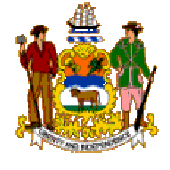













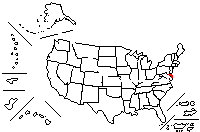
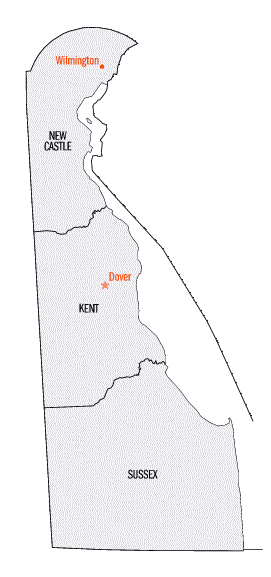

Our Delaware |
Nuestro Delaware
Oh las colinas del
|

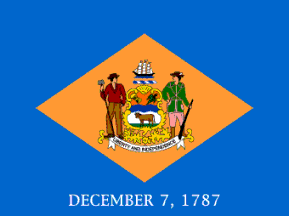
Flag:
Adopted on July 24, 1913,
the Delaware state flag has a background of colonial
blue surrounding a diamond of buff color in which the coat
of arms of the state is placed. Below the diamond are the words
"December 7, 1787," indicating the day on which Delaware
was the first state to ratify the United States constitution.
Because of this action, Delaware became the first state in the
Union, and is, therefore, accorded the first position in such
national events as presidential inaugurations. According to members
of the original commission established to design the flag, the shades
of buff and colonial blue represent those of the uniform of General
George Washington. Inside the diamond, the flag recognizes the
importance of commerce {the ship} and agriculture {wheat, corn, the ox and the farmer}
to the state. Tribute is also paid to the revolutionary war soldiers.
The words in the ribbon banner read Liberty and Independence.
Bandera:
Fué adoptada el 24 de julio de 1913. La bandera del Estado de Delaware
tienen un fondo azul colonial rodeando un diamente color piel in el cual aparece
el escudo de armas del estado. Abajo del diamante están las palabras "7 de diciembre
de 1787", indicando el dia en el cual Delaware fué ratificado como el primer estado de la
constitución de los Estados Unidos. Por esta acción, Delaware se convirtió en el primer
estado de la unión, y es por esto que se concedió la primera posición en todos los eventos
nacionales y en las inaguraciones presidenciales. De acuerdo con los miembros de la comición
original para diseñar la bandera, el matíz de color piel y azul colonial representan el uniforme
del General George Washington. Dentro del diamante, la bandera reconoce la importancia
del comercio (el barco) y la agricultura (trigo, maiz, el acha y la granja) del estado. También
aparece un soldado revolucionario en tributo a ellos. Las palabras en la cinta dicen:
Libertad e Independencia.

Delaware
Capital City: Dover
Admission to Statehood: December 7, 1787
National: Delawareans
Border States: Maryland - New Jersey - Pennsylvania
Motto: Liberty and Independence
This motto was added to the state’s great seal in 1847
as an expression of the ideals of American government.
Nicknames: First State / Diamond State / Blue Hen State/ Small Wonder
Origin of state's name: Named by USA citizanes. Named after an early Virginia governor, Lord De La Warr
Delaware (se pronuncia Dé-la-u-er en inglés y español)
Ciudad Capital: Dover (se pronuncia Dóu-ver en inglés y español)
Gentilicio: Delawarense
Admisión como estado: 7 de diciembre de 1787
Estados limítrofes: Maryland - New Jersey - Pennsylvania.
Lema: Libertad e Independencia
Este lema fué una añadido al sello del Estado en 1847 como una
expreción de los ideales del gobierno Americano.
Cognómento: Primer Estado / Estado Diamante / Estado de la Gallina Azul / Pequeña Maravilla.
Origen del nombre: Nombre dado por ciudadanos americanos. Nombrado en honor a su primer gobernador, Lord De La Warr.

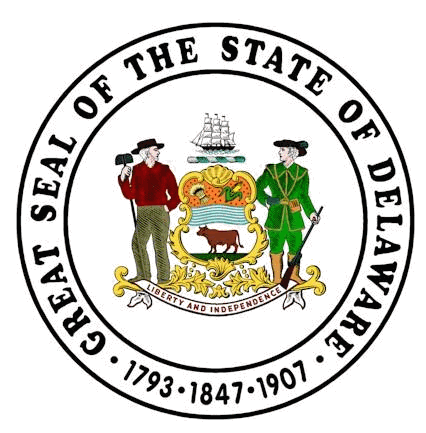
The state seal was first adopted on January 17, 1777, and contains the coat of arms. It also bears the inscription around it "Great Seal of the State of Delaware" and the dates 1793, 1847, and 1907. A description of the contents of the seal are as follows: The Wheat Sheaf -- was adapted from the Sussex County seal and signifies the agricultural vitality of Delaware. The Ship -- is a symbol of New Castle County's ship building industry and Delaware's extensive coastal commerce. The Corn -- is taken from the Kent County seal and also symbolizes the agricultural basis of Delaware's economy. The Farmer -- with the hoe represents the central role of farming to the state. The Militiaman -- with his musket recognizes the crucial role of the citizen-soldier to the maintenance of American liberties. The Ox -- represents the importance of animal husbandry to the state economy. The Water -- (above the Ox) stands for the Delaware River, the main stay of the state's commerce and transportation. The Motto -- was derived from the Order of Cincinnati, and approved in 1847. The Dates -- mark major changes to the state seal. 1793: the farmer and militiaman were omitted. 1847: the two human figures were reinstated, and the motto adopted. 1907: a modernized version of the 1777 seal, with the words "State of Delaware" added.
El sello del Estado fué adoptado el 17 de enero de 1777, y contiene el escudo de armas.
También lleva escrito al rededor "El Gran Sello del Estado de Delaware"
y las fechas 1793, 1847 y 1907. La descrición del sello es el siguiente:
El fajo de Trigo - fué una adaptación del sello del condado de Sussex y significa
la vitalidad agrícola de Delaware.
El barco - es un simbolo de la industria de construcción de barcos y el
gran comercio costero.
El maíz - es tomado del sello del condado de Kent y simboliza la base agrícola
de la economía de Delaware.
La granjero - con la azada representa el papel principal del agricultor en el estado.
El buey - representa la importancia de la cria de ganado para la economía.
El agua - (sobre el buey) representa al Río Delaware, el principal apollo del comercio estatal y transportación.
El lema - deriva de la Orden de Cincinnati y aprovado en 1847.
La fechas - marca los cambios mayores en el sello del estado. 1793: el granjero y el militar
fueron omitidos. 1847: el granjero y el militar fueron reintalados, y se adoptó el lema.
1907: se modernizó el sello de 1777 añadiendole las palabras "Estado de Delaware".

History
One of the Mid-Atlantic states, Delaware is flanked by Delaware
Bay, the Delaware River, and the Atlantic Ocean on the east;
Maryland to the south and west; and Pennsylvania to the north.
In 1609, Henry Hudson became the first European to explore the
area, and in 1638 the first permanent settlement was established
by Swedes. The state's name is derived from that of Thomas
West, Baron De La Warr, the first governor of Virginia, who
served from 1609 to 1618. During most of its history, Delaware
has combined elements of the urban, industrial north and of the
more rural, agricultural south. Although larger only than Rhode
Island, today its importance as an industrial state far exceeds
its size. For more than 150 years the du Pont family has played
a major role in Delaware's economy
and politics.
The Lenni-Lenape, or Delaware, were the original inhabitants.
In 1631 the first European settlement was attempted when the
Dutch West India Company established a tobacco-growing and whaling
industry at Zwaanendael (present-day Lewes). It lasted only a
year because of Indian attacks. In 1638, Swedish settlers
established the first permanent settlement, Fort Christina
(present-day Wilmington), as part of the colony of New Sweden.
In 1655 the colony was lost to the Dutch, who, in turn, surrendered
it to the British in 1664. In 1682, Delaware came under
the proprietorship of William Penn, but it was administered
separately from Pennsylvania as a distinct entity called the
"three counties of Delaware." Delaware became (1787) the
first state to ratify the U.S. Constitution.
Geographically and historically, Delaware has a dual personality,
which it acquired early and has never lost. New Castle County in
the north, where Wilmington is located, grew in response to
urban-industrial developments in nearby Philadelphia; Kent and
Sussex counties to the south remained rural and culturally a
part of the American South. As early as the 1730s Wilmington
was a developing grain port and shipbuilding center at the
confluence of the Christina and Delaware rivers. The Christina
gave Wilmington access to its hinterland, and nearby Brandywine
Creek provided excellent mill sites. Thus one of America's most
intensive manufacturing districts came into being. In 1802 a
French immigrant, Eleuthere Irenee du Pont de Nemours, established
a powder mill near Wilmington, beginning Delaware's chemical
industry.
By the mid-19th century the Delaware landscape had lost its
frontier appearance. In New Castle County, industry had expanded
from simple tanning, grain milling, and paper making to sophisticated
gunpowder and textile manufacturing, benefiting from improved
turnpikes, the construction (1829) of the Chesapeake and Delaware
canal, and the completion of the Philadelphia, Wilmington,
and Baltimore Railroad. In 1856 the construction of a railroad
extending the length of the state brought an agricultural boom
to southern Delaware but did not change the rural character of
the area.
Although a slave state, Delaware had less than 2,000 slaves and
about 20,000 free blacks in 1860. It was divided over the slavery
issue during the Civil War; the majority, however, was moderate and
supported the Union. Many soldiers from Delaware fought in the Union
army. After the Civil War black rights were vigorously opposed.
In 1873 blacks were effectively disenfranchised by poll taxes and
corrupt politics. The poll tax was replaced (1897) by a literacy test.
Economic growth continued after the Civil War and was concentrated
in the Wilmington area. It was aided by tax laws instituted in 1899,
encouraging corporations to locate their headquarters in Wilmington.
By 1920 the city contained almost half of Delaware's population.
Partly because of the conservative influence of southern Delaware,
the state lagged behind many others in such areas as prison reform
and social services. As a result of legislative conflict between
northern and southern factions, state unemployment insurance was
withdrawn (1934) at the height of the Great Depression. In
1968, when riots by unemployed blacks broke out in Wilmington, the
National Guard was called in. Present-day Delaware faces a problem
common to much of the United States--suburban crowding as a result
of rapid development--and continues to debate the issue of economic
growth at the expense of the environment. Fueling Delaware's economic
growth in the 1980s was the passage of laws favorable to banking and
corporate interests. By the 1990s more than 183,000 corporations
had headquarters in the state.
Historia
Uno de los estados del Atlantico medio, Delaware es flanqueado por la
bahía de Delaware, el río de Delaware, y el Océano Atlántico en el
este; Maryland al sur y del oeste; y Pennsylvania al norte. En
1609, Henry Hudson fué el primer europeo para explorar el
área, y en 1638 el primer establecimiento permanente fue establecido
por Suecos. El nombre del estado se deriva de el de Thomas West,
barón De La Warr, el primer gobernador de Virginia, que sirvió a
partir el 1609 a 1618. Durante la mayoría de su historia, Delaware
ha combinado elementos del norte urbano, industrial y del sur más
rural, más agrícola. Aunque solamente es más grande que
Rhode Island, su importancia como estado industrial excede hoy lejos su
tamaño. Por más de 150 años la familia de du Pont ha desempeñado
un papel importante en la economía y la política de Delaware.
Lenni-Lenape, o Delaware, era originalmente inavitado.
En 1631 el primer establecimiento europeo fué intentado
cuando las Indias Holandesas occidentales establecieron una
industria de siembra de tabaco y de la pesca de ballenas
en Zwaanendael (Lewes
actual). Duró solamente un año debido a ataques indios. En 1638,
los colonos suecos establecieron el primer establecimiento permanente,
Fort Christina (Wilmington actual), como parte de la colonia de
New Sweden. En 1655 los suecos perdieron la colonia, que la entregaron
a los Británicos en 1664. En 1682,
Delaware cayó bajo propiedad de Guillermo Penn, pero fue administrado
por separado de Pennsylvania mientras que una entidad distinta llamó
los " tres condados de Delaware." Delaware se convirtió en (1787) el
primer estado para ratificar la constitución de ESTADOS UNIDOS.
Geográficamente e históricamente, Delaware tiene una personalidad
dual, que adquirió temprano y nunca ha perdido. El condado New Castle
en el norte, donde localizan a Wilmington, creció en
respuesta a progresos urbano-industriales en Philadelphia próxima;
Los condados de Kent y de Sussex al sur seguían siendo rurales y
culturalmente una parte del sur americano. Desde el 1730s
Wilmington era
un centro del puerto y de la construcción naval del grano que se
convertía en la confluencia de los ríos de Christina y de Delaware.
El Christina
dió el acceso de Wilmington a su interior, y el cala próximo de
Brandywine proporcionó sitios excelentes del molino. Así vino en ser uno de los
districtos de fabricación más intensivos de América.
En 1802 un inmigrante francés, Eleuthere Irenee du Pont de Nemours,
estableció un molino del polvo cerca de Wilmington, comenzando la
industria química de Delaware. A mediados del siglo 19 el paisaje
de Delaware había perdido su aspecto de la frontera. En el condado
New Castle, la industria se había ampliado de molinos de granos a
tener un papel en a la fabricación
sofisticada de la pólvora y del textil, beneficiandose
por el cobro de peaje por la construcción (1829) del canal del
Chesapeake y
Delaware, y de la terminación de la Philadelphia, del Wilmington, y
del ferrocarril de Baltimore. En 1856 la construcción de un
ferrocarril que ampliaba la longitud del estado trajo un auge
agrícola a Delaware meridional pero no cambió el carácter rural del
área. Aunque un estado auxiliar, Delaware tenía menos de 2.000
esclavos y cerca de 20.000 negros libres en 1860. Fue dividido sobre
la edición de la esclavitud durante la guerra civil; la mayoría,
sin embargo, era moderada y apoyó la unión. Muchos soldados de
Delaware lucharon en el ejército de la unión. Después de la guerra civil
los
derechos del negro fueran cambiadas.
En
1873 los negros eran privados de sus derechos con eficacia por
impuestos y política corrupta. El impuesto de encuesta fue
substituido (1897) por una prueba liberación. El desarrollo
económico continuó después de la guerra civil y fue concentrado en
el área de Wilmington. Fue ayudado por los leyes de impuesto
instituidos en 1899, animando a las corporaciones que localicen sus
jefaturas en Wilmington. Antes de 1920 la ciudad casi contenida mitad
de la población de Delaware. En parte debido a la influencia
conservadora de Delaware meridional, el estado se quedó detrás de
muchos otros en las áreas tales como reforma de la prisión y
servicios sociales. Como resultado de conflicto legislativo entre las
facciones norteñas y meridionales, el subsidio por desempleo
del estado fué
retirado (1934) en la altura de la gran depresión. En 1968, cuando las
protestas por negros desempleados
explotaron en Wilmington, la Guadia Nacional fué activada.
Delaware actual hace frente a un problema común a mucho de los
Estados Unidos -- apretadura suburbana como resultado del desarrollo
rápido -- y continúa discutiendo la aplicación el desarrollo
económico a expensas del ambiente. Aprovisionar de combustible el
desarrollo económico de Delaware en los años 80 era el paso de los
leyes favorables a las actividades bancarias y a los intereses
corporativos. Por los años 90 más las corporaciones de 183.000
tenían jefaturas en el estado.
